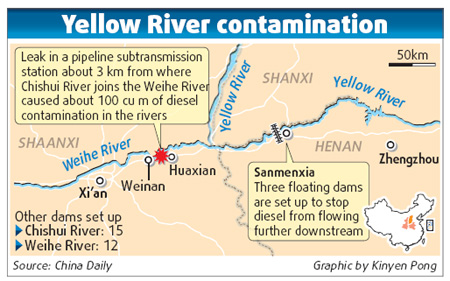Pollution to water contained to reservoir
Pollution caused by a diesel spill in Weihe River, a tributary of the Yellow River, has been effectively contained within Sanmenxia reservoir in Henan province, the Ministry of Environmental Protection said.
 |
|
Environmental workers place oil-absorbing material on the surface of the Yellow River in Shengchi county, Central China's Henan province, yesterday. The measure may limit pollution in the Xiaolangdi Reservoir. [China Daily] |
Zhang Xun, vice-director of the emergency office under the ministry, yesterday said the water quality in Sanmenxia reservoir is slightly polluted but recovering, with decreasing concentration levels of petroleum.
Monitoring results show that the Xiaolangdi Reservoir, 130 km downstream from Sanmenxia, is not polluted, Zhang said.
Water quality is also stable at the Gongyi monitoring station, located upstream of Zhengzhou, the provincial capital of Henan province.
Zhang Jianyu, vice-director of safety department at Zhengzhou Water Company, said the drinking water supply for the city is under close monitoring. Zhang said the water is safe for drinking.
The city of 2.4 million people has prepared enough drinking water for as much as 50 days in case the pollution continues to flow downstream.
"Zhengzhou has prepared 24.5 million cu m of alternative drinking water sources, and the current daily water supply is about 650,000 cu m, which means the water will be enough for all citizens for at least 37 days," Zhang said. "And if we reduce the outflow pressure of the supply, these alternative sources can be sustained for about 50 days."
About 95 percent of the city's drinking water comes from the Yellow River. The two alternative drinking water sources have a capacity of 20 million cu m, and the two water storage tanks in the city store another 4.5 million cu m of water, Zhang said.
Zhang Xiaojian, a professor with Tsinghua University, said emergency cleanup measures, including diversion channels, floating dams and absorbing agents, are proving to be effective.
 |
 0 Comments
0 Comments






